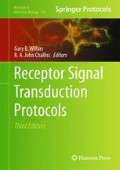Abstract
The drive to produce safer and more receptor subtype selective drugs has sparked a renewed interest in allosteric modulators of G protein-coupled receptors. The increasing use of functional assays has shown that allosteric ligands are capable of modulating both orthosteric agonist affinity and efficacy, as well as mediating receptor activation in their own right. Such a complex range of behaviours can be difficult to discern from single datasets; this chapter seeks to explain how to use radioligand binding and functional assay datasets in concert to elucidate allosteric modulator mechanism of action.
Access this chapter
Tax calculation will be finalised at checkout
Purchases are for personal use only
References
Insel, P. A., Tang, C. M., Hahntow, I., and Michel, M. C. (2007) Impact of GPCRs in clinical medicine: monogenic diseases, genetic variants and drug targets, Biochim Biophys Acta 1768, 994–1005.
Kobilka, B. K. (2007) G protein coupled receptor structure and activation, Biochim Biophys Acta 1768, 794–807.
Pin, J. P., Galvez, T., and Prezeau, L. (2003) Evolution, structure, and activation mechanism of family 3/C G-protein-coupled receptors, Pharmacol Ther 98, 325–354.
Gao, Z. G., Kim, S. K., Ijzerman, A. P., and Jacobson, K. A. (2005) Allosteric modulation of the adenosine family of receptors, Mini Rev Med Chem 5, 545–553.
Conn, P. J., Jones, C. K., and Lindsley, C. W. (2009) Subtype-selective allosteric modulators of muscarinic receptors for the treatment of CNS disorders, Trends Pharmacol Sci 30, 148–155.
Schetz, J. A. (2005) Allosteric modulation of dopamine receptors, Mini Rev Med Chem 5, 555–561.
Leach, K., Charlton, S. J., and Strange, P. G. (2007) Analysis of second messenger pathways stimulated by different chemokines acting at the chemokine receptor CCR5, Biochem Pharmacol 74, 881–890.
Hu, J. (2008) Allosteric modulators of the human calcium-sensing receptor: structures, sites of action, and therapeutic potentials, Endocr Metab Immune Disord Drug Targets 8, 192–197.
Kew, J. N. (2004) Positive and negative allosteric modulation of metabotropic glutamate receptors: emerging therapeutic potential, Pharmacol Ther 104, 233–244.
Shoback, D. M., Bilezikian, J. P., Turner, S. A., McCary, L. C., Guo, M. D., and Peacock, M. (2003) The calcimimetic cinacalcet normalizes serum calcium in subjects with primary hyperparathyroidism, J Clin Endocrinol Metab 88, 5644–5649.
Fatkenheuer, G., Pozniak, A. L., Johnson, M. A., Plettenberg, A., Staszewski, S., Hoepelman, A. I., Saag, M. S., Goebel, F. D., Rockstroh, J. K., Dezube, B. J., Jenkins, T. M., Medhurst, C., Sullivan, J. F., Ridgway, C., Abel, S., James, I. T., Youle, M., and van der Ryst, E. (2005) Efficacy of short-term monotherapy with maraviroc, a new CCR5 antagonist, in patients infected with HIV-1, Nat Med 11, 1170–1172.
Langmead, C. J., and Christopoulos, A. (2006) Allosteric agonists of 7TM receptors: expanding the pharmacological toolbox, Trends Pharmacol Sci 27, 475–481.
Motulsky, H. and Christopoulos, A. (2003) Fitting Models to Biological Data using Linear and Nonlinear Regression. A practical guide to curve fitting, GraphPad Software Inc., San Diego, CA.
Stockton, J. M., Birdsall, N. J., Burgen, A. S., and Hulme, E. C. (1983) Modification of the binding properties of muscarinic receptors by gallamine, Mol Pharmacol 23, 551–557.
Lazareno, S., Popham, A., and Birdsall, N. J. (2000) Allosteric interactions of staurosporine and other indolocarbazoles with N-[methyl-(3)H]scopolamine and acetylcholine at muscarinic receptor subtypes: identification of a second allosteric site, Mol Pharmacol 58, 194–207.
Mathiesen, J. M., Svendsen, N., Brauner-Osborne, H., Thomsen, C., and Ramirez, M. T. (2003) Positive allosteric modulation of the human metabotropic glutamate receptor 4 (hmGluR4) by SIB-1893 and MPEP, Br J Pharmacol 138, 1026–1030.
Black, J. W., and Leff, P. (1983) Operational models of pharmacological agonism, Proc R Soc Lond B Biol Sci 220, 141–162.
Leach, K., Sexton, P. M., and Christopoulos, A. (2007) Allosteric GPCR modulators: taking advantage of permissive receptor pharmacology, Trends Pharmacol Sci 28, 382–389.
Bennett, K. A., Langmead, C. J., Wise, A., and Milligan, G. (2009) Growth hormone secretagogues and growth hormone releasing peptides act as orthosteric super-agonists but not allosteric regulators for activation of the G protein Galpha(o1) by the Ghrelin receptor, Mol Pharmacol 76, 802–811.
Author information
Authors and Affiliations
Corresponding author
Editor information
Editors and Affiliations
Rights and permissions
Copyright information
© 2011 Springer Science+Business Media, LLC
About this protocol
Cite this protocol
Langmead, C.J. (2011). Determining Allosteric Modulator Mechanism of Action: Integration of Radioligand Binding and Functional Assay Data. In: Willars, G., Challiss, R. (eds) Receptor Signal Transduction Protocols. Methods in Molecular Biology, vol 746. Humana Press, Totowa, NJ. https://doi.org/10.1007/978-1-61779-126-0_10
Download citation
DOI: https://doi.org/10.1007/978-1-61779-126-0_10
Published:
Publisher Name: Humana Press, Totowa, NJ
Print ISBN: 978-1-61779-125-3
Online ISBN: 978-1-61779-126-0
eBook Packages: Springer Protocols

